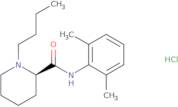(R)-(+)-Bupivacaine hydrochloride
CAS: 27262-46-0
Ref. 3D-FB19358
| 10mg | Descontinuado | ||
| 25mg | Descontinuado | ||
| 50mg | Descontinuado | ||
| 100mg | Descontinuado | ||
| 250mg | Descontinuado |
Informação sobre produto
- 1-Butyl-N-(2,6-dimethylphenyl)-2-piperidinecarboxamide monohydrochloride1-Butyl-N-(2,6-dimethylphenyl)-2-piperidinecarboxamide hydr ochloride1-Butyl-2',6'-pipecoloxylidide monohydrochloride
- 2-Piperidinecarboxamide, 1-butyl-N-(2,6-dimethylphenyl)-, monohydrochloride, (2R)-
- (+)-Bupivacaine monohydrochloride
- 2-Piperidinecarboxamide, 1-butyl-N-(2,6-dimethylphenyl)-, hydrochloride (1:1), (2R)-
- 2′,6′-Pipecoloxylidide, 1-butyl-, monohydrochloride, (+)-
- 2-Piperidinecarboxamide, 1-butyl-N-(2,6-dimethylphenyl)-, monohydrochloride, (R)-
(R)-(+)-Bupivacaine hydrochloride is a local anesthetic agent that belongs to the group of esters. It is used to provide anesthesia in surgical procedures and dental work. The profile of this drug is determined by its two active enantiomers, which are (R)-(+)-bupivacaine and levobupivacaine. The racemic mixture of bupivacaine consists of equal parts of both enantiomers, whereas levobupivacaine consists only of the levo form. Bupivacaine has been shown to be cardiotoxic when administered in high doses, but is generally not considered to be associated with any risk for neurotoxicity at therapeutic doses. Levobupivacaine does not have a significant risk for cardiotoxicity and has been shown to have reduced neurotoxicity compared with bupivacaine.





